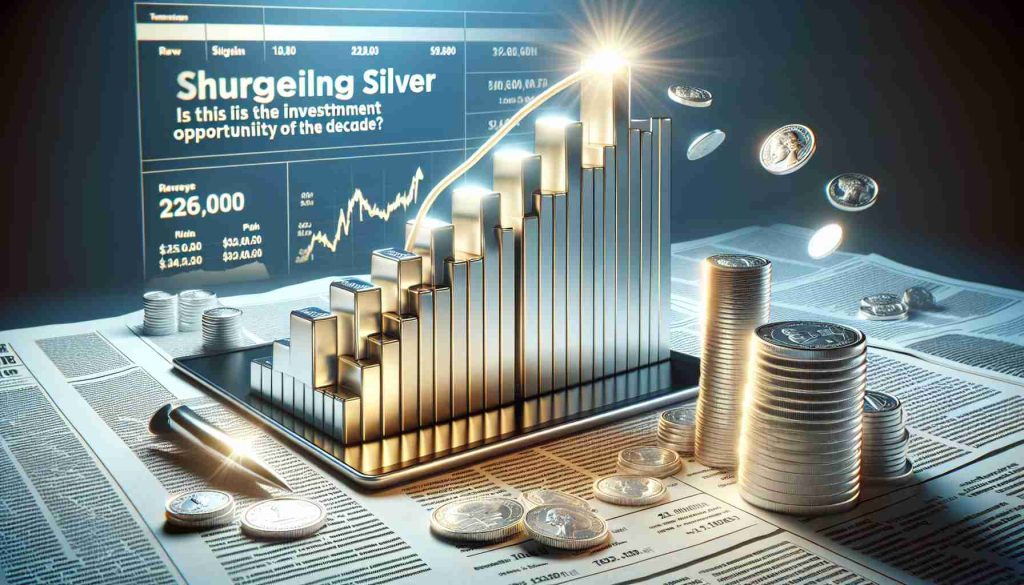- Silver prices are predicted to rise dramatically, possibly reaching $50 per ounce by mid-2025.
- The formation of the largest cup and handle pattern in silver’s history hints at a significant price breakout.
- Governments are increasingly recognizing silver’s importance as a monetary and industrial asset, especially for renewable energy technologies.
- The current gold-to-silver ratio indicates silver is potentially undervalued and may experience a significant price increase.
- Economic uncertainties and rising inflation could make silver a pivotal investment option right now.
- Investing in silver could be a strategic move as its value is anticipated to rise considerably in the evolving market.
Silver is on the brink of a breathtaking breakout, captivating investors globally. As of February 5, 2025, with prices hovering around $32.69 per ounce, analysts predict a meteoric rise to $50 by mid-year. The largest cup and handle formation in history is forming, setting the stage for what could be a remarkable surge in this precious metal.
Across the world, governments and central banks are shifting their gaze toward silver, awakening to its dual role as both a monetary and industrial asset. While gold has traditionally dominated central bank reserves, silver is emerging as an essential component of financial strategies. Countries are stockpiling silver for high-tech applications, particularly in renewable energy, signaling its growing strategic importance.
But that’s not all; investors should note the current gold-to-silver ratio standing at a staggering 88.33. Historically, this signals that silver tends to rocket upwards when overvalued compared to gold, and it has a track record of surpassing the $50 mark during previous bull runs.
With increasing uncertainty in the economy, rising inflation, and silver’s expanding utility, now might be the perfect time to reconsider your investment portfolio. The data strongly suggests silver is poised for one of its most significant rallies ever.
Don’t miss out on this opportunity; as the market evolves, so does the potential for silver to shine brighter than ever before. Investing in silver today could turn out to be the smart move that fills your coffers tomorrow. Time to harness the power of precious metals!
Silver’s Surge: Why Now is the Time to Invest
Silver is on the verge of a major breakout, capturing the attention of investors worldwide. As of February 5, 2025, prices are at approximately $32.69 per ounce, with analysts forecasting a remarkable rise to $50 by mid-year. The formation of the largest cup and handle pattern in history indicates a potential surge for this precious metal, making it a focal point for investment.
Current Trends and Insights
The dynamics of the silver market are changing as governments and central banks increasingly recognize its value. While traditionally favoring gold in their reserves, many are now accumulating silver for its critical applications in technology and renewable energy. This trend underscores silver’s growing importance in economic strategies across the globe.
Moreover, the gold-to-silver ratio is currently at a significant 88.33. Historically, such high ratios often precede substantial price increases for silver, particularly during bullish market conditions where silver has previously surpassed the $50 mark.
Features of Silver Investment
1. Dual Functionality: Silver serves as both a monetary asset and an essential raw material in various industries, including electronics, solar energy, and healthcare.
2. Historical Resilience: Silver has historically maintained value during economic downturns, acting as a hedge against inflation and currency devaluation.
3. Affordability: Compared to gold, silver is more accessible for individual investors, allowing for diversified purchasing strategies and investments.
Use Cases for Silver
– Industrial Demand: The rapid growth in renewable energy technologies, particularly solar power, is driving increased demand for silver.
– Jewelry and Ornamental Use: Silver continues to be a popular choice in jewelry and decorative arts, contributing to its market stability.
– Investment Vehicles: Options for investing in silver include physical bullion, ETFs (Exchange-Traded Funds), and mining stocks, offering various risk and return profiles.
Pros and Cons of Investing in Silver
# Pros:
– Potential for high returns, especially given current market conditions.
– Increasing demand in industrial sectors bolsters long-term value.
– Historically acts as a safe-haven asset during economic unrest.
# Cons:
– Price volatility can influence short-term investments.
– Market manipulation risks exist, particularly from large entities.
– Silver does not produce income like stocks or bonds.
Related Questions
1. What is driving the current demand for silver?
– The increasing utilization of silver in technologies such as solar panels, electronics, and electric vehicles is creating significant industrial demand, alongside its role as a monetary asset.
2. How does the gold-to-silver ratio affect investment decisions?
– A high gold-to-silver ratio often suggests that silver is undervalued relative to gold, indicating a potential for price corrections upward for silver as historical trends show increases in silver prices following similar conditions.
3. What are the risks associated with investing in silver?
– Risks include market volatility, the potential for value depreciation, and economic factors such as inflation and currency fluctuations that can impact silver prices.
For more information on silver market trends and investment strategies, visit Kitco.
